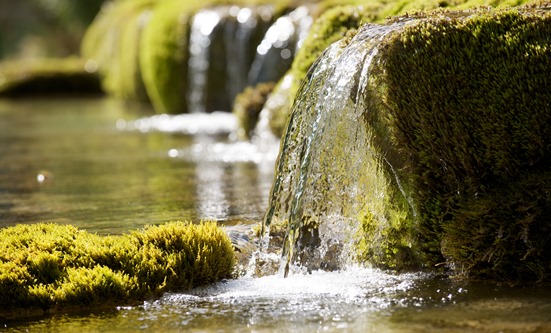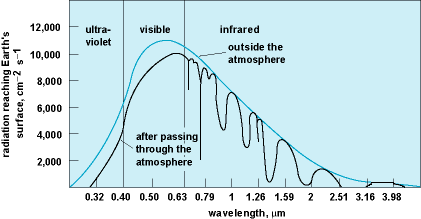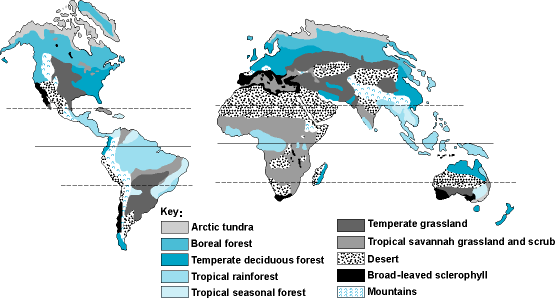Key Concepts
The sum of all external factors, both biotic (living) and abiotic (nonliving), to which an organism is exposed. All of the outside factors to which an organism is exposed comprise its environment (Fig. 1). The environment has a tremendous influence on an organism's ability to live. Biotic factors include influences by members of the same and other species on the development and survival of the individual. Primary abiotic factors are light, temperature, water, atmospheric gases, and ionizing radiation, influencing the form and function of the individual. In general, for each environmental factor, an organism has a tolerance range in which it is able to survive. The intercept of these ranges constitutes the ecological niche of the organism. Different individuals or species have different tolerance ranges for particular environmental factors; this variation represents the adaptation of the organism to its environment. The ability of an organism to modify its tolerance of certain environmental factors in response to a change in them represents the plasticity of that organism. Alterations in environmental tolerance are termed acclimation. Exposure to environmental conditions at the limit of an individual's tolerance range represents environmental stress. See also: Adaptation (biology); Ecology; Physiological ecology (animal); Physiological ecology (plant)

Abiotic factors
All the physical factors that affect an organism constitute the abiotic environment.
Light radiation
The spectrum of electromagnetic radiation reaching the Earth's surface is determined by the absorptive properties of the atmosphere (Fig. 2). Biologically, the most important spectral range is 300–800 nanometers (nm), incorporating ultraviolet, visible, and infrared radiation. Visible light provides the energy source for most forms of life. Light absorbed by pigment molecules (chlorophylls, carotenoids, and phycobilins) is converted into chemical energy through photosynthesis. Light availability is especially important in determining the distribution of plants. Plants receiving too little light (low light stress) may be unable to maintain an average photosynthetic rate that is high enough to support net growth. Excess light (high light stress) causes damage to leaf tissue, which may kill the plant in extreme cases. Moreover, photosynthetic organisms can exist within a wide range of light intensities. For example, full sunlight in the tropics is around 2000 μmol photons · m−2 · s−1; in contrast, photosynthetic organisms have survived in locations where the mean light is as low as 0.005% of this value. See also: Insolation; Light; Photosynthesis; Solar radiation

In addition to providing energy, light is important in providing an organism with information about its surroundings. The human eye, for example, is able to respond to wavelengths of light between 400 and 700 nm—the visible range. Within this range, sensitivity is greatest in the green part of the spectrum. This is the portion of the spectrum that plants absorb least, and thus is the principal part of the spectrum to be reflected.
Temporal variation in light also provides an important stimulus, and life forms are typically able to detect and respond to daily light fluctuations. Such a response may be directly controlled by the presence or absence of light (diurnal rhythms) or may persist when the variation in light is removed (circadian rhythms). In the latter case, regulation is through an internal molecular clock, which is able to predict the daily cycle. Such circadian clocks are normally reset by light on a daily basis. Processes controlled by circadian clocks range from the molecular (gene expression) to the behavioral (for example, sleep patterns in animals or leaf movements in plants). The ability to detect changes in day length is also essential to many biological processes. Day-length changes are used by organisms to predict seasonal changes. For example, shortening of days, indicating the onset of winter, is used as a cue to trigger hibernation or migration in animals, and flowering, seed set, and leaf loss in plants. See also: Biological clock; Circadian clock (plants); Hibernation and estivation; Photoperiodism
Ultraviolet radiation represents a form of stress. It has the ability to break chemical bonds and may lead to damage to proteins, lipids, and nucleic acids. Damage to deoxyribonucleic acid (DNA) may result in genetic mutations. The amount of ultraviolet radiation reaching the Earth's surface is thought to be increasing due to depletion of the ozone layer in the stratosphere. Ozone is responsible for absorbing a large proportion of ultraviolet radiation reaching the outer atmosphere. As ozone is destroyed by the action of pollutants (for example, chlorofluorocarbons), the proportion of ultraviolet radiation reaching the surface of the Earth rises. See also: Mutation; Stratospheric ozone; Ultraviolet radiation; Ultraviolet radiation (biology)
Water
Water is ubiquitous in living systems and is the universal solvent for life. A sufficient supply of water is essential for biological activity. Many organisms have evolved the ability to survive prolonged periods in the total absence of water, but this is achieved only through the maintenance of an inactive state. Water availability remains a primary environmental factor limiting survival on land. Primitive land organisms possess little or no ability to conserve water within their cells and are termed poikilohydric. Examples include amphibians and primitive plants, such as most mosses and liverworts. These are confined to places where water is in plentiful supply (for example, close to ponds), or they must be able to tolerate periods of desiccation. Lichens can survive total water loss and rapidly regain activity upon rewetting. Such organisms must be able to minimize the damage caused to cellular structures when water is lost. Dehydration causes irreversible damage to membranes and proteins. This damage can be prevented by the accumulation of protective molecules termed compatible solutes. See also: Amphibia; Lichens; Water
Homeohydric organisms possess a waterproof layer that restricts the loss of water from the cells. Such waterproofing is never absolute because there is still a requirement to exchange gas molecules and to absorb organic or mineral nutrients through a water phase. Overall, though, water conservation allows organisms to live in environments in which the water supply is extremely low. In extremely arid environments, behavioral adaptations may allow the water loss to be minimized. Animals may be nocturnal, emerging when temperatures are lower and hence evaporation minimized. Cacti possess a form of photosynthesis [crassulacean acid metabolism (CAM)] that allows them to separate gas exchange and light capture. See also: Osmoregulatory mechanisms; Plant-water relations
Temperature
Temperature is a determinant of survival in two ways: (1) as temperatures decrease, the movement of molecules slows and the rate of chemical reactions declines; and (2) temperature determines the physical state of water. See also: Temperature
The slowing of metabolic activity at low temperatures is illustrated in reptiles. Such poikilothermic animals, unable to maintain their internal temperature, are typically inactive in the cold of morning. They bask in the sun to increase their body temperature and become active. High temperatures will cause the three-dimensional structure of proteins to break down, preventing the organisms from functioning. Organisms adapted to extremely high temperatures need more rigid proteins that maintain their structure. Temperature also affects the behavior of cell membranes, made up of lipids and proteins in a liquid crystalline state. At low temperatures, the membrane structure becomes rigid and liable to break. At high temperatures, it becomes too fluid and again liable to disintegrate. In adapting to different temperatures, organisms alter the composition of the lipids in their membranes, whose melting temperature is thereby changed. This outcome also applies to storage lipids. Hence, cold-water fish are a useful source of oils, whereas mammals, with their higher body temperature, contain fats. The effect of temperature on membranes is thought to be a key factor determining the temperature range that an organism is able to survive. See also: Cell membrane; Lipid; Metabolism; Protein; Temperature adaptation in animals
The effect of temperature on the physical state of water is essential to determining the availability of that water to organisms. Poikilothermic organisms may find that the water in their cells begins to freeze at low temperatures. Certain species can survive total freezing through the prevention of ice crystal formation altogether, which would otherwise damage cellular structures. To survive low temperatures, cells must be able to survive desiccation, and thus low-temperature tolerance involves the formation of compatible solutes. High temperatures increase the rate of evaporation of water. Hence, in locations where water supply is limiting, an organism's ability to survive high temperatures is impaired.
Mammals and birds, that is, homeothermic organisms, are able to regulate their internal temperature, limiting the effects of external temperature variations. However, temperature still acts as an environmental constraint in such organisms. Cooling is achieved through sweating and hence loss of water. Heat is produced through the metabolism of food, and survival in cold climates requires a high metabolic rate. See also: Cryptobiosis; Thermoregulation
Atmospheric gases
The atmosphere on Earth is thought to be determined to a large extent by the presence of life. At the same time, organisms have evolved to survive in the atmosphere as it is. The atmospheric constituents with the most direct biological importance are oxygen (O2) and carbon dioxide (CO2). Oxygen makes up approximately 20% of the atmosphere and is due to the occurrence of oxygenic photosynthesis. This process involves the simultaneous uptake of CO2 to make sugars. Aerobic respiration involves the reverse of this process, that is, the release of CO2 and the uptake of O2 to form water. Hence, the current atmosphere represents the balance of previous biological activity. For most terrestrial organisms, neither CO2 nor O2 is limiting in the atmosphere; however, the need to get either or both of these gases to cells may represent a limitation on size or on the ability to tolerate water stress. Limitation of either gas may be important in aquatic environments, where the concentration of each is significantly lower. See also: Atmosphere; Carbon dioxide; Oxygen; Photorespiration; Respiration
Nitrogen is also required by all organisms, but it cannot be used by most in the gaseous form. Nitrogen fixation, the conversion of N2 gas into a biologically useful form, occurs in some species of bacteria and cyanobacteria or may be caused by lightning. See also: Nitrogen; Nitrogen fixation
Atmospheric gases are important in determining the climate and the light environment. Absorption of electromagnetic radiation by the atmosphere determines the spectrum of light reaching the Earth's surface. Absorption and reflectance of infrared radiation by greenhouse gases, such as CO2 and water vapor, regulate temperature. See also: Greenhouse effect
Ionizing radiation
Ionizing radiation entering the atmosphere as cosmic rays or generated through the decay of radioactive material may have a significant effect on the survival of organisms. High-level exposure to radiation may directly damage tissues, ultimately killing the individual. Lower levels of radiation may cause damage to DNA, leading to the accumulation of genetic mutations. These mutations are frequently deleterious, but they also give rise to beneficial genetic variations. See also: Radiation; Radiation biology
Other factors
Other environmental factors determining the range, distribution, and form of organisms are mechanical stimuli, such as wind or water movement, and the presence of metals, inorganic nutrients, and toxins in the air, soil, or food. Environmental factors particularly relevant in aquatic environments include water pressure and salinity.
Biotic factors
The biotic environment of an individual is made up of members of the same or other species. Intraspecific interactions involve the need to breed with other individuals, to gain protection through living in a group, and to compete for resources, including food, light, nutrients, and space. The optimal population density depends on the availability of resources and on the behavior, size, and structure of the organism. Interspecific interactions also may be positive or negative. For example, symbiotic relationships may involve the mutual benefit of the individuals involved, whereas competition for resources is deleterious to both. Other symbiotic relationships may be positive to one species and negative to the other. For example, a parasite gains benefit from its host, but exerts a negative influence on that individual. Such relationships are not simple. Although predation exerts a negative influence on the population as a whole, the success of an individual may be enhanced if a predator removes one of its conspecific competitors. See also: Mutualism; Predator-prey interactions; Symbiosis
The impact of humans on natural environments may be considered a special case among biotic factors. Humans alter their environment in ways that exceed the impact of all other organisms. For example, the release of greenhouse gases into the atmosphere contributes to climate alterations over the entire planet. This in turn has effects on the distribution of all other species. The release of pollutants into the environment brings organisms into contact with stresses to which they were not previously exposed. This causes the evolution of new varieties, eventually perhaps new species, adapted to the polluted environments. See also: Air pollution; Biosphere; Global climate change; Human ecology; Water pollution
Limiting factors and environmental stress
For any given organism, it is often possible to identify a factor in the environment that limits survival and growth. The limiting factor may change through time. Such a change may cause the organism to be at the limit of or outside its tolerance range for that or another environmental factor. In such cases, the organism is said to suffer stress. If the stress to which an individual is exposed is extreme, it may result in irreversible damage and death. Exposure to moderate stress, however, results in a period of acclimation within the organism that allows it to adjust to the new conditions. Organisms exposed gradually to new conditions usually have a higher chance of survival than those exposed suddenly. See also: Population ecology
Environment and biomes
In locations where a particular environmental factor (or combination of factors) dominates the growth and development of organisms, it is often found that the adaptations and gross features of the landscape will be the same, even when the actual species are different. Thus, Mediterranean vegetation is found not only around the Mediterranean Sea, but also in California and South Africa, where the conditions of hot dry summers and warm wet winters occur. Regions with similar environmental conditions are classed as biomes (Fig. 3). The occurrence of such global vegetation types clearly illustrates the role played by the environment in determining the form and function of individual species. See also: Biome






